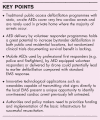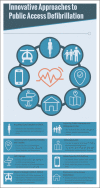Public access defibrillation: challenges and new solutions
- PMID: 37093002
- PMCID: PMC10155700
- DOI: 10.1097/MCC.0000000000001051
Public access defibrillation: challenges and new solutions
Abstract
Purpose of review: The purpose of this article is to review the current status of public access defibrillation and the various utility modalities of early defibrillation.
Recent findings: Defibrillation with on-site automated external defibrillators (AEDs) has been the conventional approach for public access defibrillation. This strategy is highly effective in cardiac arrests occurring in close proximity to on-site AEDs; however, only a few cardiac arrests will be covered by this strategy. During the last decades, additional strategies for public access defibrillation have developed, including volunteer responder programmes and drone assisted AED-delivery. These programs have increased chances of early defibrillation within a greater radius, which remains an important factor for survival after out-of-hospital cardiac arrest.
Summary: Recent advances in the use of public access defibrillation show great potential for optimizing early defibrillation. With new technological solutions, AEDs can be transported to the cardiac arrest location reaching OHCAs in both public and private locations. Furthermore, new technological innovations could potentially identify and automatically alert the emergency medical services in nonwitnessed OHCA previously left untreated.
Copyright © 2023 The Author(s). Published by Wolters Kluwer Health, Inc.
Conflict of interest statement
Figures



Similar articles
-
Local lay rescuers with AEDs, alerted by text messages, contribute to early defibrillation in a Dutch out-of-hospital cardiac arrest dispatch system.Resuscitation. 2014 Nov;85(11):1444-9. doi: 10.1016/j.resuscitation.2014.07.020. Epub 2014 Aug 15. Resuscitation. 2014. PMID: 25132473
-
Bystander Defibrillation for Out-of-Hospital Cardiac Arrest in Public vs Residential Locations.JAMA Cardiol. 2017 May 1;2(5):507-514. doi: 10.1001/jamacardio.2017.0008. JAMA Cardiol. 2017. PMID: 28297003 Free PMC article.
-
The challenges and possibilities of public access defibrillation.J Intern Med. 2018 Mar;283(3):238-256. doi: 10.1111/joim.12730. Epub 2018 Feb 12. J Intern Med. 2018. PMID: 29331055 Review.
-
Effectiveness of public-access automated external defibrillators at Tokyo railroad stations.Resuscitation. 2021 Jul;164:4-11. doi: 10.1016/j.resuscitation.2021.04.032. Epub 2021 May 6. Resuscitation. 2021. PMID: 33964334
-
Automated external defibrillators and the link to first responder systems.Curr Opin Crit Care. 2023 Dec 1;29(6):628-632. doi: 10.1097/MCC.0000000000001109. Epub 2023 Oct 4. Curr Opin Crit Care. 2023. PMID: 37861209 Review.
Cited by
-
American Heart Association Automated External Defibrillator Symposium: Summary and Recommendations.J Am Heart Assoc. 2025 Apr;14(7):e039291. doi: 10.1161/JAHA.124.039291. Epub 2025 Mar 19. J Am Heart Assoc. 2025. PMID: 40105094 Free PMC article.
-
A narrative review of inherited arrhythmogenic syndromes in young population: role of genetic diagnosis in exercise recommendations.BMJ Open Sport Exerc Med. 2024 Jul 2;10(3):e001852. doi: 10.1136/bmjsem-2023-001852. eCollection 2024. BMJ Open Sport Exerc Med. 2024. PMID: 38975025 Free PMC article. Review.
-
The Interaction Effect of Age, Initial Rhythm, and Location on Outcomes After Out-of-Hospital Cardiac Arrest: A Retrospective Cohort Study.J Clin Med. 2024 Oct 26;13(21):6426. doi: 10.3390/jcm13216426. J Clin Med. 2024. PMID: 39518565 Free PMC article.
-
Cardiac Arrest: Can Technology Be the Solution?J Clin Med. 2025 Feb 3;14(3):972. doi: 10.3390/jcm14030972. J Clin Med. 2025. PMID: 39941642 Free PMC article.
-
Logistic and cognitive-emotional barriers experienced by first responders when alarmed to get dispatched to out-of-hospital cardiac arrest events: a region-wide survey.Intern Emerg Med. 2024 Apr;19(3):813-822. doi: 10.1007/s11739-023-03487-2. Epub 2023 Dec 21. Intern Emerg Med. 2024. PMID: 38123905
References
-
- Benjamin EJ, Virani SS, Callaway CW, et al. . Heart Disease and Stroke Statistics-2018 Update: a report from the American Heart Association. Circulation 2018; 137:e67–e492. - PubMed
-
- Hallstrom AP, Ornato JP, Weisfeldt M, et al. . Public-access defibrillation and survival after out-of-hospital cardiac arrest. N Engl J Med 2004; 351:637–646. - PubMed
-
- Hasselqvist-Ax I, Riva G, Herlitz J, et al. . Early cardiopulmonary resuscitation in out-of-hospital cardiac arrest. N Engl J Med 2015; 372:2307–2315. - PubMed
-
- Coute RA, Mader TJ, Kurz MC. Evaluation of National Institutes of Health cardiac arrest research based on ‘chain of survival’ links. Acad Emerg Med 2022; 29:1381–1382. - PubMed
-
- Guidelines for cardiopulmonary resuscitation and emergency cardiac care. Emergency Cardiac Care Committee and Subcommittees, American Heart Association. Part II. Adult basic life support. JAMA 1992; 268:2184–2198. - PubMed
Publication types
MeSH terms
LinkOut - more resources
Full Text Sources
Medical
Research Materials

